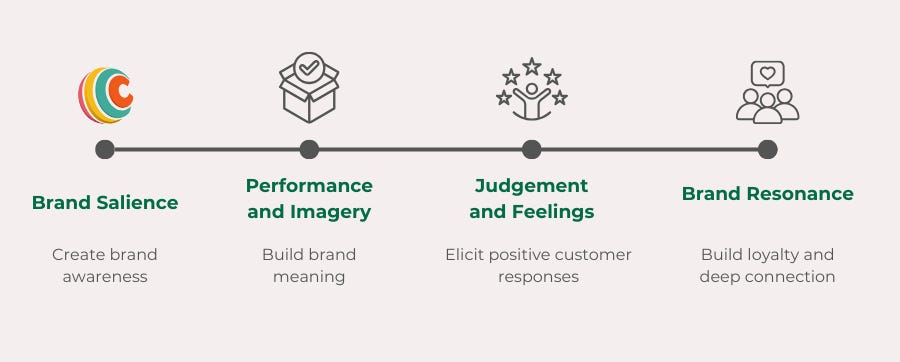How to build a brand from scratch
Learn how to build a brand from scratch with this comprehensive guide. Discover the key steps, strategies, and tools to create a brand that resonates with your audience.
From my experience working with clients and students, I've noticed that many find building a brand from scratch challenging. Although it can seem difficult at first, it's a rewarding process that allows you to establish a powerful presence in the market and create meaningful connections with your target audience, ultimately driving business growth. I often emphasize, "A brand might not sell directly, but without one, selling becomes significantly more difficult."
In this article, I aim to guide you through the essential steps of building a brand from the ground up, drawing insights from industry experts and successful brand stories.
1. Define your brand's foundation
Before diving into the creative aspects of branding, it's important to establish a solid foundation for your brand. This involves defining your brand's core purpose, values, and target audience.
a) Identify your target audience
To build a brand that resonates with your customers, you need to know who you're trying to reach. Identify your target audience by considering their demographics (age, gender, location, income), psychographics (lifestyle, interests, values), and their needs and pain points. Create buyer personas to represent your ideal customers, outlining their characteristics and motivations.
For example, if you're launching a new line of organic skincare products, your target audience might be health-conscious individuals aged 25-45 who are interested in sustainable living and natural ingredients.
b) Define your brand's purpose and position
Every successful brand has a clear purpose - a reason for being. Ask yourself the following questions:
What is the unique value your brand provides?
What problem does it solve for your target audience?
Craft a clear mission statement that encapsulates your brand's purpose and how it aims to serve its customers. This statement will guide your branding efforts and ensure consistency in your messaging. To define your brand position, pinpoint your direct competitors and identify what makes your brand stand out.
For example, if you're starting a coffee shop, your mission statement might be "To provide a welcoming space where people can connect over high-quality, ethically sourced coffee." Your brand position might be to offer a unique experience that combines specialty coffee with a focus on community involvement and sustainability, differentiating you from larger chains or cafes that prioritize speed and convenience over quality and ethical sourcing.
c) Determine your brand values
Identify the core values that will guide your brand's actions and decisions. These values should reflect your brand's personality and resonate with your target audience.
For example, if sustainability is important to your brand, ensure that this value is reflected in your products, packaging, and messaging.
Brand values are the guiding principles and beliefs that your company stands for. By articulating your values and aligning your brand with something bigger and more meaningful than yourself, your customers will see that your brand is relatable and real and that this truth extends far beyond just your product and service offerings.
2. Develop your brand identity
With a solid foundation in place, it's time to develop the visual and verbal elements that will represent your brand. A comprehensive brand style guide is essential to maintaining consistency in branding across different platforms. This guide should document your company's preferred fonts, imagery, logos, colors, visual assets, voice, and values to guarantee consistency.
a) Choose a brand name
Your brand name should be memorable, easy to pronounce, and relevant to your business. Consider factors like your target audience, brand values, and the overall tone you want to convey.
For example, if you're targeting a younger audience with a tech product, a short, catchy name with a modern feel might be appropriate.
b) Create a logo and visuals
Your logo is the visual cornerstone of your brand. It should be unique, memorable, and reflect your brand's personality. Consider using colors, fonts, and imagery that align with your brand values and resonate with your target audience. First impressions are important, and a well-designed logo can make a lasting impact on potential customers.
For example, the Nike swoosh is instantly recognizable and conveys a sense of movement and energy, aligning with the brand's focus on athletic performance.
c) Build your brand messaging
Develop a consistent brand voice and tone that reflects your brand's personality. This includes your tagline, marketing copy, and any other communication materials. Ensure that your messaging is clear, concise, and resonates with your target audience. Consider how brands like Nike and Coca-Cola leverage emotional storytelling to connect with their audience. Consistent messaging across all platforms builds trust and credibility with consumers.
d) Write your brand story
Craft an engaging brand story that connects with your audience on an emotional level. Share your brand's origins, challenges, and aspirations. This story should humanize your brand and make it more relatable to your customers. Authentic storytelling helps customers connect with a brand on a personal level.
For example, TOMS Shoes built its brand around the story of its founder's trip to Argentina, where he witnessed the impact of poverty on children. This story resonated with customers and helped establish TOMS as a brand with a social mission.
3. Build your brand presence to reach your audience
Once you have a strong brand identity, you must establish your market presence.
a) Choose the right marketing channels
Identify the marketing channels that will effectively reach your target audience. This could include social media, email marketing, content marketing, paid advertising, video marketing, blogging, podcasting, influencer marketing, and more. Tailor your marketing strategies to each channel and ensure consistency in your branding.
For example, if your target audience is active on Instagram, focus on creating visually appealing content that aligns with your brand aesthetic.
b) Create valuable content
Develop high-quality content that provides value to your target audience. This could include blog posts, articles, videos, infographics, and more. Share your expertise, educate your audience, and build relationships through valuable content.
c) Engage with your audience
Actively engage with your audience on social media and other platforms. Respond to comments, answer questions, and foster a sense of community around your brand. Building relationships with your customers is crucial for long-term success.
4. Maintain brand consistency and authenticity
Consistency and authenticity are essential for building a strong brand. Ensure that your brand identity is consistently represented across all touchpoints, including your website, social media, marketing materials, and customer service interactions. This consistency builds trust and reinforces your brand message. Authenticity is crucial for building a brand that resonates with your audience. Stay true to your brand values and communicate honestly and transparently with your customers. This builds trust and fosters long-term loyalty.
5. Leverage branding tools and resources to streamline your efforts
Building a brand can be a complex process, but there are plenty of tools and resources available to help you streamline your efforts and achieve your goals.
Brand management platforms: Tools like Frontify can help you create and maintain brand guidelines, store your brand assets (logos, fonts, images), and ensure consistency across all platforms.
Design tools: Canva and Adobe Illustrator are great examples of design tools that can help you create visually appealing content that aligns with your brand identity.
Marketing automation tools: Platforms like Mailchimp can help you automate your marketing efforts, ensuring consistent brand messaging and freeing up your time to focus on other tasks.
Branding websites and blogs: Explore websites and blogs dedicated to branding for inspiration, insights, and best practices.
Branding templates and downloads: Downloadable resources like "Brand Strategy Made Simple" and "The Branding Deck Template" can provide you with helpful frameworks and templates to guide your branding process.
Branding books: Books like "Building a Story Brand" by Donald Miller offer in-depth guidance and practical advice on crafting compelling brand narratives.
6. Learn from successful brands to gain insights
Observing how established brands have built their identities and achieved success can provide invaluable insights for your own brand-building journey.
a) Analyze their strategies
Study the branding strategies of brands like Nike, Coca-Cola, and Starbucks. Identify what makes them successful and how they connect with their target audience.
For example, Nike's "Just Do It" tagline is a powerful call to action that resonates with athletes and inspires them to push their limits. This tagline has become synonymous with the brand and has helped establish Nike as a leader in the sports industry.
b) Identify their key elements
Pay attention to the key elements of their brand identity, such as their logo, messaging, and brand voice. Learn how these elements contribute to their overall brand image.
For example, Coca-Cola's iconic red logo and classic imagery evoke feelings of happiness and nostalgia, creating a strong emotional connection with consumers.
7. Avoid common branding mistakes
While there's no single formula for brand building, there are some common mistakes you should avoid.
Inconsistent branding: Avoid inconsistencies in your brand messaging and visual identity across different platforms. This can confuse your audience and damage your brand's credibility.
Ignoring your target audience: Don't try to be everything to everyone. Focus on your target audience and tailor your branding efforts to their needs and preferences.
Chasing trends: While it's important to stay current, avoid blindly following design trends that may quickly become outdated. Focus on building a timeless brand identity that reflects your core values.
Not prioritizing first impressions: Even if the product or service is excellent, a brand with a clunky design or an unappealing website can go unnoticed. Make a strong first impression with a visually appealing presentation that reflects your brand identity.
8. Adapting and evolving your brand to stay relevant
The business world is constantly changing, and brands need to adapt to stay relevant. Observe how brands like Netflix have evolved from a DVD rental service to a global streaming giant by anticipating consumer trends and adapting their offerings. Not having a Plan B can be detrimental to your brand, as unforeseen circumstances or market shifts may require you to adjust your strategies.
9. Understanding the stages of brand building to build a success roadmap
The brand-building process can be broken down into four key stages:
Conclusion
Building a brand from scratch is a journey that requires careful planning, consistent effort, and a deep understanding of your target audience. By following these steps and learning from successful brands, you can create a strong brand identity that resonates with your customers and establishes a lasting presence in the market.
Let’s start building your own brand!




